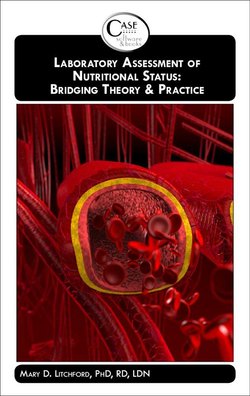Читать книгу Laboratory Assessment of Nutritional Status: Bridging Theory & Practice - MARY LITCHFORD - Страница 10
На сайте Литреса книга снята с продажи.
ОглавлениеBiochemical Assessment of Nutritional Status
Biochemical assessment is an essential tool to assess the body’s ability to convert food into body components. It is the foundation of the nutrition intervention program, one of the measuring sticks by which to evaluate its success and to predict medical outcomes.
National trends indicate a declining number of laboratory tests are being ordered in all areas of health care. This trend is a reflection of a better understanding of the predictive value of certain tests and cost-reduction programs nationwide. Assessment of physical and nutritional status is done primarily through physical assessment and observed dietary intake. Justification for ordering laboratory tests is based on observed clinical signs and symptoms.
Laboratory tests are based on analysis of blood and urine samples, which contain nutrients, enzymes and metabolites that reflect protein, vitamin and mineral status, presence of other components in body fluids. Common studies include enzymes, serum lipids, electrolyte levels, red and white blood cell counts, clotting factors and breakdown products such as urea nitrogen.
Blood
The total volume of blood in the human body is approximately 5-6 liters or 8 percent of body weight. Plasma is the fluid remaining after the cellular elements have been removed from the blood. Serum is obtained by clotting the blood before the removal of cells. The serum then does not contain the protein fibrinogen required for blood clotting.
The pH of the blood is in a range between 7.36 and 7.44. The buffer system helps to maintain the pH within this narrow range.
An increase or decrease in the cellular elements or constituents of the blood can be indicative of a nutritional deficiency, disease and acute or chronic blood loss. Blood analysis results are used for diagnosis as well as following the course of the deficiency, disease or recovery from injury or trauma.
Patients receiving blood transfusions have laboratory test results that reflect the nutritional status of the blood donor. The purpose of the transfusion is to replete the patient’s body with key components. Interpretation of lab tests following a transfusion does not reflect the patient’s true ability to convert food into body components.
Urine
Urine is a mixture of water, inorganic salts and organic compounds. The major inorganic ions excreted are cations, sodium, potassium, calcium, magnesium and ammonium. The anions are chloride, phosphate and sulfate. The nitrogenous and non-nitrogenous organic compounds excreted in the urine are the waste products of metabolism. Water-soluble vitamins and their metabolites may be excreted in the urine. The volume of urine excreted is approximately 600 to 2500 mL per day. The normal pH range of urine is between 4.6 and 8.0 with an average of 6.0 (Pagana, 2009), depending on time of sampling and what food was consumed. The specific gravity of urine falls between 1.005 and 1.029 (Pagana, 2009), but can be affected by dehydration, renal disease, diabetes, fever and aging.
Urinalysis reports include remarks about the color, appearance and odor of the urine. Tests performed include pH, presence of protein, glucose, ketones, blood, and leukocyte esterase. The urine is examined microscopically for red and white blood cells (WBC), casts, crystals and bacteria. While nutritional assessment has focused primarily on blood analysis, some urine tests are included.
